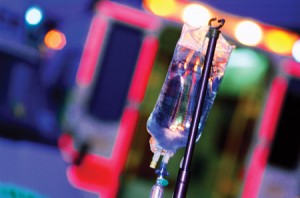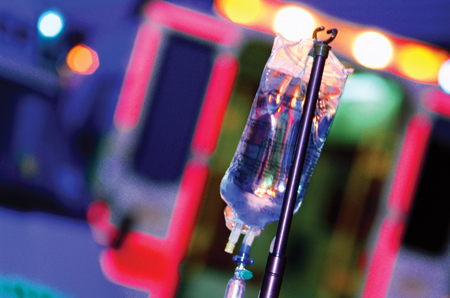Earn 1 Contact Hour – Free of Charge
The goal of this CE activity is to provide nurses and nurse practitioners with knowledge and skills to recognize and manage acute hypersensitivity reactions (HSRs) occurring as a result of medication administration. After reading this article, you will be able to:
- Recognize early signs and symptoms of acute HSRs
- Describe evidence-based nursing and medical management of HSRs
- Discuss prevention of HSRs
An acute hypersensitivity reaction is a rare but serious complication of exposure to foods, natural-rubber latex, medications, and other antigens. Patient allergies are not always clearly defined in the medical record, and severe reactions may not be anticipated. Nurses and nurse practitioners must recognize HSR risk factors, read early signs and symptoms, and intervene to protect the patient from further harm.
Authors: Brenda Shelton, MSN, RN, CCRN, AOCN; and Jane C. Shivnan, MScN, RN, AOCN
What are Hypersensitivity Reactions?
A hypersensitivity reaction (HSR) is an exaggerated immune response to an antigen which results in local tissue injury and may include life-threatening systemic effects. The most extreme form of HSR is anaphylaxis or anaphylactoid reactions, a life-threatening emergency. Common antigens eliciting HSRs include foods such as peanuts and shellfish, environmental antigens such as natural rubber latex, venoms such as those from bee stings and fire ants, and medications such as antibiotics, monoclonal anti-bodies and chemotherapy. Although acute HSRs generally occur within minutes of antigen exposure, there is a wide spectrum of HSR presentations-including biphasic and delayed reactions-that may occur hours to days after antigen exposure. The type of reaction is determined by the primary immunologic mechanism as outlined in Table 1, although it is important to be aware that HSRs in clinical practice often involve multiple immune pathways and may be difficult to categorize.
 For the purposes of this CE activity, we will limit our discussion to acute HSRs resulting from exposure to medications and biologic agents. Most of these are categorized as Type I or anaphylactic HSRs. Type I reactions manifest almost immediately upon anti-gen exposure. The primary mediator of Type I reaction is immunoglobulin E (IgE). Anaphylactoid or pseudo-anaphylactic reactions produce identical symptoms, but are not charac-terized by progressive symptoms with each exposure or the presence of IgE antibody. All HSRs are complex immune responses of mast cell degranulation activating histamine release, complement system, prostaglandins, and inflammatory leuko-trienes. The effects of these immune response mediators are responsible for most of the symptoms seen in HSRs, whether they are cutaneous reaction char-ac-terized by itching and hives (histamine) or bronchospasm and vasospasm (leukotrienes and prostaglandins).
For the purposes of this CE activity, we will limit our discussion to acute HSRs resulting from exposure to medications and biologic agents. Most of these are categorized as Type I or anaphylactic HSRs. Type I reactions manifest almost immediately upon anti-gen exposure. The primary mediator of Type I reaction is immunoglobulin E (IgE). Anaphylactoid or pseudo-anaphylactic reactions produce identical symptoms, but are not charac-terized by progressive symptoms with each exposure or the presence of IgE antibody. All HSRs are complex immune responses of mast cell degranulation activating histamine release, complement system, prostaglandins, and inflammatory leuko-trienes. The effects of these immune response mediators are responsible for most of the symptoms seen in HSRs, whether they are cutaneous reaction char-ac-terized by itching and hives (histamine) or bronchospasm and vasospasm (leukotrienes and prostaglandins).
Table 1: Immunology of HSR’s
| Type | Mechanism | Signs and Symptoms |
| I | Anaphylactic: Immediate immunoglobin E-mediated reaction | Fever, nausea, vomiting, flushing, back pain, angioedema, rash, dyspnea, bronchospasm, feelings of impending doom, circulatory collapse |
| II | Cytotoxic: Antigen-antibody complexes activate inflammatory pathways | Hemolysis |
| III | Serum Sickness: Immune complexes form and deposit in various tissues | Vasculitis, nephritis, arthritis |
| IV | Delayed Cytotoxic: Activated T cells destroy targeted cells | Graft rejection, contact dermatitis, granuloma formation, Graft-Versus-Host Disease |
When are acute HSRs likely to occur?
Acute HSRs are rare, with 1-15% of Americans considered at risk if exposed to known allergens.1 Of those who experience anaphylaxis, approximately 1% will die as a result.1 In hospitalized patients, anaphylactic reactions account for about 6% of reported adverse drug reactions.2 HSRs are more likely to occur with intravenous administration. Complex, protein-based molecules are more likely to elicit the immune-mediated response of an acute HSR, which accounts for the increased incidence of acute HSRs with infusions of biological agents such as antisera or monoclonal antibodies. These agents are often administered in ambulatory settings to patients with diseases such as Crohn’s disease, multiple sclerosis, auto-immune disorders, and cancers. Some smaller molecules, like the penicillins, bind to circulating serum proteins, resulting in increased size and antigenic potential in susceptible individuals. Some diluents used in medication admixture contribute to the risk for HSR.3 Cremophor, for example, is a diluent for paclitaxel, cyclosporin, and tenoposide.
Table 2: Definition of Anaphylaxis
(National Institute of Allergy and Infectious Disease/ Food Allergy and Anaphylaxis Network)
Diagnostic Criteria for AnaphylaxisSymptom onset within minutes to hours of exposure to antigen including symptoms involving the skin or mucosal tissue with any one of the following: hives, pruritis, airway edema, with respiratory difficulty or hypotension.ORAny two of the following within minutes to hours of antigen exposure:
- Skin or mucosa involvement
- Respiratory distress
- Hypotension, or
- Gastrointestinal symptomsORHypotension within minutes to hours after antigen exposure
Source: Sampson HA, Munoz-Furlong A, Campbell RL, et al. Second symposium on the definition and management of anaphylaxis: summary report-Second National Institute of Allergy and Infectious Disease/ Food Allergy and Anaphylaxis Network symposium, J Allergy Clin Immunol, 2006; 117(2): 391-397.
Oncology nurses are particularly likely to witness HSRs from antimicrobials, biological and chemotherapeutic agents. All chemotherapy has the potential to cause an HSR. Chemotherapeutic agents with the highest reported incidence of HSRs include L-asparaginase (10-35%), taxanes (2-5%), platinum compounds (10-27%), etoposide and teniposide (6-40%), and procabazine.4 Platinum compound HSRs are considered IgE-mediated, occurring after seven to nine doses have been safely administered. On the other hand, nearly 95% of reactions to taxanes and L-asparaginase occur during the first or second infusion.
Monoclonal antibodies used in medi-cine, neurology, cardiology and oncology can cause severe infusion reactions induced by cytokine release. Although these are not Type I acute HSRs, their implications for assessment and management are similar. The incidence of reactions with monoclonal antibodies varies: rituximab (up to 75%), trastuzumab (up to 40%), cetuximab (19%), infliximab (1-6%), bevacizumab (1%), natalizumab (1%), and abiciximab (0.6%).
Severe HSRs may also be triggered by medications used to manage general medical-surgical conditions. As many as seven individuals in a thousand may experience angioedema upon exposure to ACE inhibitors.2 Other medications known to cause significant HSRs include anesthetics, anticonvulsants, antiarrhythmics, aspirin, radiocontrast media, and sedative-hypnotics. Antibiotics such as penicillins, beta lactams, sulfonamides, and trimethoprim sulfamethoxazole also commonly trigger HSRs of variable severity.
What are the signs and symptoms of acute HSRs?
Some of the signs and symptoms of acute HSRs overlap with milder infusion reactions. Patients may experience fevers, chills, rigors, flushing, and diaphoresis (sweating) as temperature regulation is disrupted by circulating cytokines. Histamine release from mast cell degranulation may cause pruritis (itching) and rashes, including hives. Arthralgias (joint pain) and myalgias (muscle pain) may occur. The patient may complain of a headache, dizziness, abdominal pain, or nausea.
Serious systemic effects include dyspnea, bronchospasm, cyanosis, tachycardia, and hypotension or hypertension. Abdominal or lower back pain may indicate visceral smooth muscle contraction. The patient may also experience a sense of impending doom, may lose consciousness, and may suffer a circulatory collapse. A uniquely life-threatening event in an acute anaphylactic HSR is angioedema, a rapid swelling of tongue and throat tissues that can obstruct the patient’s airway. Life-threatening HSRs are more likely to occur with intravenous administration, which places the antigen into the blood-stream, particularly with more rapid infusion rates.
Nurses should be alert to possible symptoms during and immediately after administration of the at-risk agent. Initial subtle symptoms may progress to life-threatening complications within minutes. Anaphylaxis diagnostic criteria are described in Table 2. Clinical suspicion is augmented with diagnostic tests to validate HSRs, so that future antigen exposure can be controlled. Allergen-specific IgE levels are available for some drug allergens, but can be complemented with nonspecific tests of immunologic activity such as eosinophilia, serum total tryptase, or flow-cytometry basophil activation assays on CD63 and CD203c.
How should acute HSRs be managed?
Stop, Call, Assess, Prepare.
If you suspect your patient is experiencing early symptoms of an acute HSR, donÕt hesitate to implement your emergency interventions. STOP the infusion but maintain IV access. CALL the provider. ASSESS your patient further: collect vital signs, use a pulse oximeter to obtain oxygen saturation, listen to breath sounds, and check for symptom progression. Finally, PREPARE for emergency treatment, including the potential need to administer IV fluids, oxygen, and resuscitative medications.
The most likely acute HSR medica-tion orders for adults include epinephrine (0.3-0.5 ml of a 1:1000 solution as intramuscular or subcutaneous injection, repeated every five to fifteen minutes), albuterol (two puffs from a multi-dose inhaler), a rapid-acting corticosteroid such as hydrocortisone 100 mg, and an antihistamine such as diphenhydramine 50 mg. For pediatric patients, epinephrine at 0.01 mg/kg is repeated every five minutes as necessary. IV fluids, vasopressors such as norepinephrine, and histamine 1 receptor blocker such as ranitidine may also be ordered. Oxygen therapy is appropriate for most patients, but is only effective if bronchospasm is effectively controlled.
Your organization may have developed a protocol for managing severe anaphy-lactic hypersensitivity reactions. These treatment algorithms are generally based on expert opinion and consensus; there is limited published evidence due to the rarity of HSRs and the urgency of management.2 Some controversial components of therapy include the best route for epinephrine administration and preferred vasopressor agents. Intravenous epinephrine administration is associated with extreme tachycardia and myocardial ischemia. Intramuscular and subcutaneous administration may be equivalent if there is not excess edema or obesity. Dopamine is associated with enhanced tachycardia, but higher efficacy of norepinephrine has not been established. The administration of histamine 2 receptor blockers such as ranitidine (50 mg IV) is a common practice, but is not based upon clinical evidence of efficacy.
If your patient is experiencing angio-edema, be aware that an emergency crychothryrotomy or tracheostomy may be needed. Availability of emergency surgical airway supplies and expert clini-cians is recommended when admin-istering agents with high risk for HSRs.
An acute HSR is a frightening experience. After the initial event, supportive care and close monitoring will be needed for several hours to ensure that symptoms do not recur. Immediate-acting medications treating the reaction may dissipate before the agent that triggered it does, and residual antigens can cause a recurrence of symptoms 4Ð6 hours after the initial event.5 The patient and family members will need explanations of treatments and reassurance that close monitoring and proactive strategies can prevent harm. For some patients who experience mild HSRs, it may be appropriate to consider readministration of the agent in spite of the reaction. This should only be attempted under carefully controlled and monitored conditions, with premedications and a slower infusion rate. Published desensitization protocols exist for some medications and may be useful in these situations.
An acute HSR is also an adverse drug reaction (ADR) and should be reported according to your organizationÕs policies. The World Health Organization defines an ADR as “any response to a drug which is noxious and unintended, and which occurs at doses normally used in humans for prophylaxis, diagnosis, or therapy of disease, or for the modification of physiological function.”6 Enhanced reporting of ADRs will assist in defining true incidences of drug reactions.
Can acute HSRs be prevented?
Recognizing high-risk patients and situations is an essential first step in reducing HSR morbidity and mortality. Clinical variables known to increase risk for HSRs include personal history of drug allergy, multiple allergy syndrome, presence of Epstein-Barr or HIV infection, or concurrent asthma. For high-risk medications, premedications with antihistamines and corticosteroids are widely used. Skin testing may be performed before administration of medications with high incidence of HSRs. Desensitization protocols may also be useful in preventing IgE-mediated HSRs. Most involve administering a greatly diluted amount of the antigenic agent (usually a dose in micrograms, rather than milligrams) and then gradually increasing the dose every 15 to 30 minutes to induce tolerance.2 The patient must be closely monitored by experienced healthcare personnel, as reactions are still possible.
Key Points
In summary, hypersensitivity reactions to food, medications and biological agents are uncommon but potentially serious reactions that require astute nursing assessment and critical thinking skills.Paramount to this proactive approach is recognition of allergenic risk factors and significant signs or symptoms before they become life-threatening. Readily available emergency supplies and medications can minimize the adverse outcomes of severe HSRs.
Earn free contact hours at: www.ijhn.jhmi.edu
This activity is free to read here, but you also have an opportunity to earn contact hours for free! All you have to do is go to www.ijhn.jhmi.edu, register for this activity, and pass the short posttest. When you register for this activity, you will instantly become a member of the IJHN community and will see this activity listed on your homepage. Simply click the link on your homepage to electronically access the activity, posttest, course evaluation, and upon passing the posttest, a downloadable certificate. This 1-contact-hour educational activity (which includes 0.2 of pharmacology hours) is provided by the Institute for Johns Hopkins Nursing. Contact hours will be awarded until March 30th, 2013.To receive contact hours, visit www.ijhn.jhmi.edu and register for this activity online by clicking here or call 443-287-4745 to request materials in the mail.
References
1Neugut AJ, Ghatak AT, Miller RL. (2001). Anaphylaxis in the United States: An investigation into its epidemiology. Arch Intern Med, 161(1): 15-21.
2Kanji S & Chant C. (2010). Allergic and hypersensitivity reactions in the intensive care unit. Crit Care Med, 38(6), S162-S168.
3Gobel BH. (2005). Chemotherapy-induced hypersensitivity reactions. Onc Nurs Forum, 32(5), 1027-1035.
4Syrigou E, Makrilia N, Koti I, et. al. (2009). Hypersensitivity reactions to antineoplastic agents: an overview. Anti-Cancer Drugs, 20, 1-6.
5Viale PH. (2009). Management of hypersensitivity reactions: A nursing perspective. Onc Nurs Forum, 23(2),
6Safety of Medicines: A Guide to Detecting and Reporting Adverse Drug Reactions. Geneva, Switzerland, World Health Organiza-tion, 2002. Available at: http://whqlibdoc.who.int/hq/2002/WHO_EDM_QSM_2002.2.pdf. Accessed January 26, 2010
.

 You’re Welcome
You’re Welcome Nursing Named Most Trusted Profession for 22nd Consecutive Year
Nursing Named Most Trusted Profession for 22nd Consecutive Year Best of On The Pulse 2023
Best of On The Pulse 2023 From the Dean: Here & Now
From the Dean: Here & Now The Learning Collaborative: ‘I Think I Can, I Think I Can …’
The Learning Collaborative: ‘I Think I Can, I Think I Can …’







